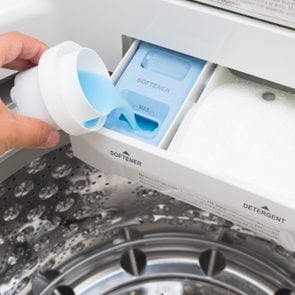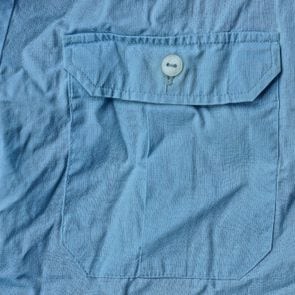How to Wash Silk Without Damaging Your Clothing
Updated: May 22, 2024

Known for its delicacy, silk is a natural fiber that requires special handling. Here, experts break down exactly how to wash silk without damaging the lustrous fabric.
Even if you know how to do laundry, learning how to wash silk, including how to hand-wash silk, is an advanced skill that’s worth mastering—it will help you save money on dry cleaning and can help to preserve the lifespan of your precious silk clothing and accessories.
A delicate natural fiber known for its shine and softness, silk requires special handling and know-how. As a fabric-care and laundry expert, I’ve honed plenty of experience through hands-on washing and drying and interviewing professionals on the subject, including specialty dry cleaners and the scientists who formulate and test laundry detergents. And, of course, I’ve washed my own silk items. Because silk has such a temperamental reputation, getting started can feel nerve-racking. But washing silk at home is truly an easy, affordable and effective way to clean this beautiful fabric.
Here, we’ve included an expert-approved guide on silk washing, including whether it’s appropriate to machine-wash silk; the right washing machine temperature for laundering silk items; and which is better, air-drying or machine-drying. For more insight on silk, we also tapped Wendy Saladyga, a stain expert for Henkel, the manufacturer of All, Persil, Purex and Snuggle detergents and fabric softeners. Here’s what you need to know.
Get Reader’s Digest’s Read Up newsletter for more cleaning, humor, travel, tech and fun facts all week long.
About the expert
|
Is it better to wash or dry-clean silk?
Silk can be washed with water and detergent, or it can be sent for professional cleaning. A professional cleaner will determine the best approach based on the item’s construction, and they will either dry-clean the garment using solvents or wash the item by hand using water and a pH-neutral detergent.
Typically, the decision to dry-clean silk is simply one of convenience and an abundance of caution: Because silk is such a delicate and, let’s be honest, temperamental fabric, many people choose to send silk clothing and accessories out for professional cleaning to mitigate the potential for costly or irreversible damage. And that is a perfectly fine and reasonable choice to make!
There are some other instances in which you might choose to dry-clean silk. Silk is prone to color loss and bleeding, so silk garments that are not colorfast should be dry-cleaned rather than washed by hand or in the machine, where exposure to water can cause fugitive dye to ruin the item. In addition, if the silk item in question is heavily embellished with beading, buttons or other frippery, dry cleaning will be the best choice to ensure the embellishments don’t sustain damage during cleaning.
Silk has a reputation for being damage-prone when exposed to water, which is why some people find at-home cleaning intimidating. While it is true that water can stain silk, leaving spots or uneven color, using proper washing techniques and limiting the time silk is exposed to water will prevent damage from occurring. In addition, silk is more prone to damage when it is wet. When silk is wet, its fibers weaken, making it susceptible to rips, tears, warping and stretching.
What to know before washing silk
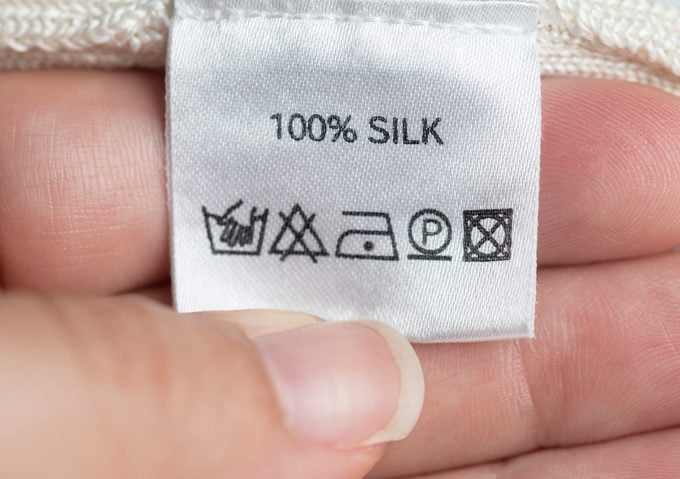
Silk is a delicate fabric that requires special handling—you can’t just chuck a silk blouse in the wash with your yoga pants and hoodies! Before washing silk, bear these tips in mind for the best results.
- Check the care label. Make sure you understand laundry symbols and always check the care tag for guidance on how to clean a silk garment properly.
- Test for colorfastness. To test silk for colorfastness, I’ll dampen a small area of the garment with cool water and dab at it with a white or light-colored cloth. If dye comes up on the cloth, the silk is not colorfast and should be dry-cleaned with solvents rather than washed with water and detergent.
- Avoid laundry products that contain bleach or other harsh ingredients. It’s best to use a delicate detergent formulated to be safe on silk. However, non-specialty laundry detergents can absolutely be used to hand- or machine-wash silk, provided they don’t contain any of the following: chlorine bleach, oxygen bleach, enzymes, alcohol, protease or alkalis.
- Consider a no-rinse detergent. No-rinse detergents are just what they sound like—laundry detergents that are formulated so they do not need to be rinsed out of fabric, and I strongly recommend them for people who wash delicate fabrics like silk by hand.
- Avoid exposure to direct sunlight. Silk should be air-dried, but avoid drying silk in direct sunlight. I have found that sunlight can cause fading and other forms of heat-related damage.
| ♦ Expert tip |
| Wash with cold or cool water. Silk is prone to fading and color loss, which can be exacerbated by exposure to warm or hot water. When washing silk, opt for cold or cool water. |
How to hand-wash silk

Hand-washing silk will almost always be a better choice than machine-washing. Silk does not like to be over-handled, so washing by hand will always be preferred. Machine-washing creates more agitation, even on gentle settings, than hand-laundering.
Supplies you’ll need
- No-rinse delicate detergent, such as Soak
- Absorbent towel
- Mesh drying rack (optional but recommended)
1. Check the care label
Check the garment’s care label for specific washing instructions. Look for guidance on water temperature as well as which products to avoid, such as bleach or alkaline detergents.
2. Fill the sink with cool water
Fill the sink or wash basin with cool water. When filling the sink, it’s crucial to leave enough headspace to fully submerge the garment and for your hands to move through the water without displacing it or causing overflow.
3. Add detergent
Add detergent to the wash water, distributing and dissolving it by using your hands to swirl it around. Follow package instructions for dosing recommendations, being careful not to overuse the detergent—using too much detergent will create residue buildup that can change the look and feel of silk.
| ♦ Expert tip |
| Use a no-rinse detergent. Silk does not like to be over-handled, so no-rinse detergents, which require less agitation and do not need to be rinsed out, are ideal for washing silk. Plus, they make the hand-washing process simpler by removing the rinse step. |
4. Submerge and soak garment
Submerge the garment in the detergent solution, and using your hands, gently swirl the item in the wash water to penetrate the fibers. Then, allow the item to soak for at least five minutes but not more than 15 minutes.
5. Drain the sink and extrude wash water from garment
Drain the wash water from the sink. Gently press down on the garment to extrude as much water as possible; do not wring, twist or otherwise roughly handle the silk.
6. Roll in an absorbent towel

Remove the garment from the sink and place it on a clean, dry, absorbent towel. Carefully roll it up, jelly roll style, gently pressing down to extrude more water.
7. Air-dry flat
Air-dry silk garments flat, ideally on a flat mesh drying rack. Do not hang silk to dry; the weight of the wet fabric can pull the garment, leaving it vulnerable to damage, including ripping, tearing or misshaping. Silk should be air-dried in a cool space, and it should not be exposed to direct sunlight.
| ♦ Expert tip |
| Do not wring silk. Silk is a delicate material that should not be treated roughly, especially when it’s wet and more vulnerable to damage. Do not wring or twist silk to remove water. Use a light touch when handling. |
How to machine-wash silk
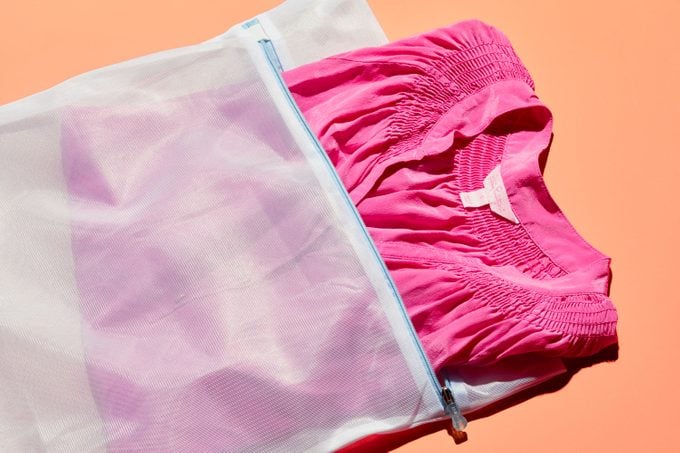
While hand-washing is most often preferred, machine-washing silk is possible, but it does require extra care and supplies.
Supplies you’ll need
- Silk-safe laundry detergent
- Mesh washing bag
- Mesh drying rack (optional but recommended)
1. Check the care label
Check the garment’s care label for specific washing instructions. Look for guidance on water temperature as well as which products to avoid, such as bleach or alkaline detergents.
2. Wash in a garment bag with like items
If you choose to machine-wash silk, wash the garment alongside other lightweight, delicate items. Place the silk garment in a mesh washing bag, which can add another layer of protection against friction from other items. Do not wash silk clothing or accessories in the same load as bulky or heavy items, such as jeans, sweats or towels.
3. Use cold water and gentle settings
Silk should always be laundered using cold water. Select the gentlest cycle available on your washing machine, which may be called gentle, delicate, hand-wash or slow-slow (“slow-slow” refers to the speed at which the drum moves during the rinse and spin cycles, which are at their slowest when the delicate cycle is engaged). If there is a timer option on your washer, choose the shortest overall washing cycle available to avoid exposing silk to excessive agitation.
4. Air-dry flat
Air-dry silk garments flat, ideally on a flat mesh drying rack. Do not hang silk to dry; the weight of the wet fabric can pull the garment, leaving it vulnerable to damage and misshaping. Silk should be air-dried in a cool space, and it should not be exposed to direct sunlight.
| ♦ Expert tip |
| Never machine-dry silk. While machine-washing is OK, you should avoid machine-drying entirely. Machine-drying can expose silk garments to high heat, and the agitation of the drum can cause irreversible damage to the delicate material. |
How to get stains out of silk

Supplies you’ll need
- Distilled white vinegar
- Water
- Spray bottle
- White cloth
1. Test for colorfastness
Test for colorfastness by dampening a small area of the garment with cool water, then dab at it with a white or light-colored cloth. If color transfers from the garment to the cloth, the fabric is not colorfast and should be sent out for professional cleaning to avoid irreversible damage.
2. Make a silk-safe stain-removing solution
To make a solution that’s silk-safe, mix 2 cups of distilled water with 2 tablespoons of white vinegar in a clean spray bottle.
3. Apply stain remover
Apply the stain removing solution to the stain, taking care not to oversaturate the area. Use a white or light-colored cloth to gently work the stain remover into the stain. Avoid rubbing, scrubbing or otherwise roughly handling the silk.
4. Launder as usual
After treating the stains, launder the garment as usual using either of the two methods outlined in this article.
FAQs
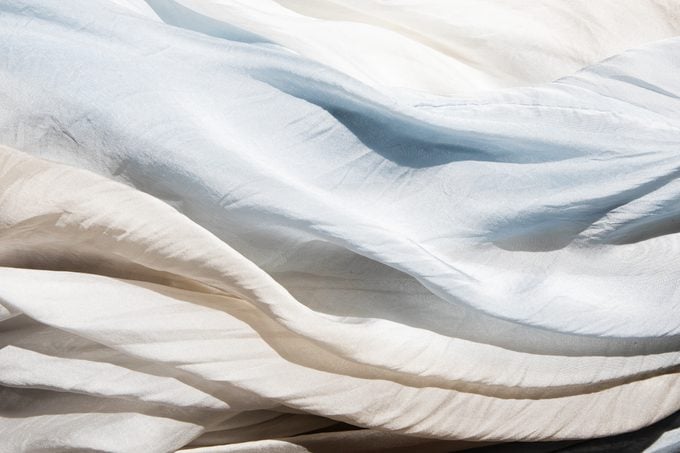
Can you machine-wash 100% silk?
Yes, but with reservations. “In some cases, you can machine-wash 100% silk,” Saladyga says, “but it depends on the item. Always check the care label to ensure that your items don’t need to be hand-washed or dry-cleaned.”
Is it better to wash or dry-clean silk?
Both are good choices. Washing will be fine for most silk clothing and accessories, but you may choose professional cleaning for convenience, or for cleaning embellished silk without running the risk of damage. “It depends on what the care label of the silk garment says,” Saladyga explains. “For more delicate silk materials or silk materials that are heavily embellished, the care label may recommend dry cleaning.”
What happens when silk gets wet?
When silk gets wet, the fibers weaken, which can cause silk clothing and accessories to shrink or lose their shape. Exposure to water can also cause color loss in silk, and the use of hot water, in particular, can fade colored silk. Silk is also prone to water stains.
What water temperature is best for washing silk?
It’s recommended to wash silk with cool water, Saladyga says. “However, consult the care label to see if the item has particular water temperature requirements.”
What is the best detergent for washing silk?
Use a pH-neutral no-rinse detergent formulated for silk. No-rinse detergents require less agitation, making them ideal for washing silk clothing and accessories.
Should I use white vinegar when washing silk?
It is not necessary. White vinegar is sometimes used as a rinse agent when hand-laundering silk clothing and accessories to neutralize alkali found in many detergents. However, if you’ve used a detergent formulated for use on silk, the vinegar rinse is not needed and will only serve to subject the silk to unnecessary handling and agitation.
Can you hand-wash silk if it says “dry-clean only”?
“If the care label of the silk garment recommends ‘dry-clean only’ then that’s the best route to take to ensure that no damage is caused to the delicate fabric,” Saladyga says. That is a conservative approach to fabric care, but many silk garments labeled dry-clean only can successfully be washed by hand or in the machine.
Can silk go in the dryer?
That’s a hard no, Saladyga says. “Don’t put silk clothes or fabrics in the dryer. If you’ve washed it in the machine, carefully smooth the garment and dry it flat,” she says. “If you’ve hand-washed it, gently roll the silk garment in a towel, keeping the item flat as you roll to get most of the water out and then smooth and dry flat. Do not twist or wring, as that will cause the silk to wrinkle.”
How do you de-wrinkle silk?
If the wrinkled silk is wet, lay the silk item flat to dry, smoothing the fabric with your hands to reduce wrinkling. To de-wrinkle silk that is already dry, press it using an iron on the cool setting; place a pressing cloth or other protective barrier between the iron and the fabric to avoid causing damage.
Why trust us
At Reader’s Digest, we’re committed to producing high-quality content by writers with expertise and experience in their field, in consultation with relevant, qualified experts. For this piece, Jolie Kerr tapped her experience as a longtime cleaning expert and advice columnist. Then fabric-care and stain-removal expert Mary Marlowe Leverette gave it a rigorous review to ensure that all information is accurate and offers the best possible advice to readers. For this piece, we relied on reputable primary sources, including cleaning and health experts and reputable organizations. We verified all facts and data and backed them with credible sourcing, and we will revisit them over time to ensure they remain accurate and up to date. Read more about our team, our contributors and our editorial policies.
Sources:
- Wendy Saladyga, stain expert and senior manager of technical performance for Henkel; email interview, Jan. 25, 2024
- SilkPedia: “How Long Can Silk Sit in Water: Essential Durability Guide”





















